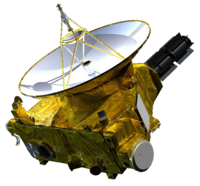
Photo from wikipedia
Hyperspectral imaging is a popular style of image acquisition which captures a multitude of two-dimensional images at different frequencies to yield more information from a scene. For imaging in certain… Click to show full abstract
Hyperspectral imaging is a popular style of image acquisition which captures a multitude of two-dimensional images at different frequencies to yield more information from a scene. For imaging in certain frequency ranges, point-scanning images pixel-by-pixel is the only option for imaging and consequently can require prohibitively long measurement times. This paper introduces a non-uniform compressed sensing strategy for recovering whole hyperspectral images with much fewer samples than normally required. Our methods use the known variability of measurements across training subjects to weight random sampling toward unreliable hyperspectral points. This strategy is used to heavily reduce remote hyperspectral image acquisition time while maintaining or improving recovery performance. To test our methods, we focus on the problem of recovering hyperspectral images for non-destructively detecting malicious dormant hardware Trojans hidden in integrated circuits. These non-destructive detection techniques require remote hyperspectral measurements of the backscattering electromagnetic side channel; which can only be performed by point-scanning with existing technologies. We detect covert hardware Trojan circuit modifications with state-of-the-art performance while requiring up to ten times fewer measurements than prior methods. We compare performance of a uniform-random and our weighted-random compressed sensing strategy for the 2-dimensional discrete cosine transform bases as well as with learned dictionary bases.
Journal Title: IEEE Access
Year Published: 2022
Link to full text (if available)
Share on Social Media: Sign Up to like & get
recommendations!